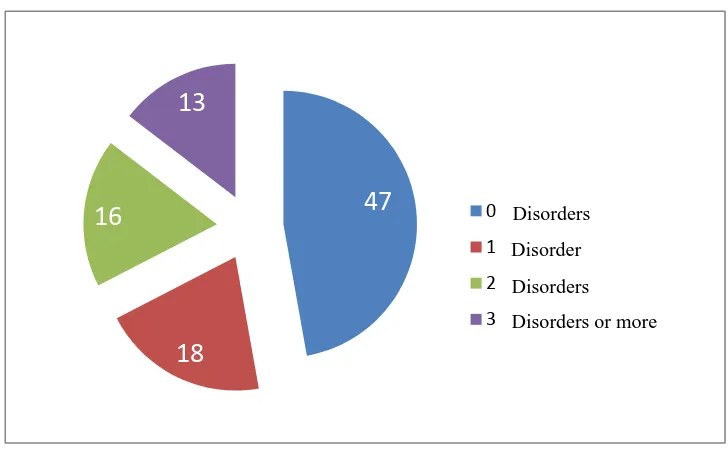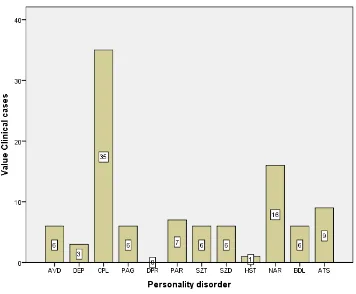HYPERION UNIVERSITY www.hyperion.ro
20
PERSONALITY DISORDERS AMONG
FUTURE PSYCHOLOGISTS
STELIANA RIZEANU a FLORIN ENE a a
Hyperion University, Faculty of Psychology and Educational Sciences Department of Psychology
Abstract
Taking into account the growing incidence of personality disorders in the general population and the daily life problems they lead to, we decided to study the prevalence of personality disorders among future psychologists.
We used a test group of 89 subjects made up of psychology students and MA students of the Clinical Psychology and Counselling Psychology Master’s programme from the Hyperion University. In order to diagnose personality disorders we used the Structured Clinical Interview for DSM-IV Axis II Personality Disorders – SCID II (First et al, 2007).
The results show that 53% of the subjects meet the criteria for personality disorder diagnosis, out of whom 20% have one personality disorder, 18% two personality disorders and 15% three or more personality disorders. The most common personality disorder among the psychology students is the obsessive compulsive disorder found in 35 of the subjects, representing 39.3% of the test group.
Keywords: personality disorders, psychologists, diagnostic.
1. INTRODUCTION
Prevalence of personality disorders in the general population is approximately 10% (Lenzenberger, Lane, Loranger, Kessler, 2007; Samuels, Eaton, Bienvenu et. al, 2002; Sansone and Sansone, 2011).
Research carried out by Torgersen, Kringlen and Cramer (2001) on a group of 2053 people aged 18 to 65 in Norway showed that the prevalence of personality disorders was 13.4% and the highest prevalence was among subjects with only high school education or less, and living without a partner. The most frequent were Corresponding author: Steliana Rizeanu
21
the avoidant, schizoid and paranoid personality disorders, the least common being the borderline. Zimmerman, Rothschild and Chelminski (2005) carried out research on a number of 859 psychiatric outpatients who were interviewed with the Structured Interview for DSM-IV Axis II Personality Disorders upon presentation for treatment. Results showed that 270 of them, amounting to 31.4% of the total group were diagnosed with one of the ten personality disorders officially recognized, the most common being avoidant, borderline and obsessive-compulsive personality disorder.
Research carried out by Gawda and Czubak (2017) in Poland on a group of 1460 nonclinical people proved that 8.9% out of them had at least one personality disorder, the most prevalent being obsessive-compulsive (9.6%), narcissistic (7%), and borderline (7%).
Research carried out by Chabrol and his collaborators (2001) on a group of 60 high school students showed that 26.7% met the criteria for the borderline personality disorder diagnosis, 16.6% for depression and 10% for dependent personality disorders.The Longitudinal Study of Personality Disorders carried out by Sansone and Sansone (2011) analysed the prevalence of personality disorders in a university population of 2000 and concluded that overall prevalence of personality disorders in this young community sample was 11.0 percent.
2. OBJECTIVE AND HYPOTHESES
2.1.OBJECTIVE
The main objective of the present paper is determining the prevalence of personality disorder among the future psychologists.
2.2.HYPOTHESES
Our hypothesis is that the prevalence of personality disorder among the future psychologists is higher than in the general population.
3. METHOD
3.1. PARTICIPANTS
22
47
18
16
13
0 tulburari
1 tulburare
2 tulburari
3 sau peste 3.2. INSTRUMENTS
In order to diagnose personality disorders we used the Structured Clinical Interview for DSM-IV Axis II Personality Disorders SCID II (First et al, 2007).
4. RESULTS
When applying the SCID II questionnaire, 47 out of the total number of subjects, representing 53% of the group, were diagnosed with personality disorders, out of whom 18 subjects (20%) with one personality disorder, 16 subjects (18%) with two personality disorders and 13 subjects (15%) three or more personality disorders (figure 1).
Figure 1. Diagnosis with one or more personality disorders
The descriptive statistics on the number of the criteria obtain for each personality disorder in our group are shown in table 1.
The most frequent personality disorder within our experimental group is the obsessive-compulsive disorder found in 35 of the subjects, representing 39.3% of the total, followed by the narcissistic personality disorder diagnosed in 16 subjects (17.9% of the group), and the antisocial personality disorder diagnosed in 9 of the subjects (10.1%).
Disorders
Disorders or more Disorders
23 Table 1. Descriptive statistics
Descriptive Statistics N Mini
mum Maxi mum Mea n Std. Deviat ion
Skewness Kurtosis
Stati stic Stati stic Stati stic Stati stic Statisti c Statisti c Std. Error Statisti c Std. Error Avoidant 89 0 6 1.13 1.375 1.603 .255 2.668 .506 Dependent 89 0 7 1.36 1.416 1.447 .255 2.330 .506 Compulsive 89 0 8 3.19 1.833 .368 .255 -.402 .506
Passive-Agressive 89 0 5 1.30 1.326 .855 .255 -.037 .506 Depressive 89 0 4 .74 1.103 1.521 .255 1.623 .506 Paranoid 89 0 5 1.10 1.415 1.197 .255 .469 .506 Schizotypal 89 0 6 2.00 1.438 .657 .255 -.198 .506 Schizoid 89 0 5 1.15 1.293 1.109 .255 .646 .506 Histrionic 89 0 6 .99 1.133 1.557 .255 3.460 .506 Narcissistic 89 0 10 2.78 2.315 .888 .255 .570 .506 Borderline 89 0 9 1.70 2.019 1.731 .255 3.358 .506 Antisocial 89 0 6 .67 1.213 2.217 .255 5.223 .506 Valid N
(listwise) 89
Obsessive-compulsive personality disorder is characterized by perfectionism, order, high standards and rigid beliefs (Rowland, Jainer & Panchal, 2017). People with this disorder have unwanted and repeated thoughts and sensations and the study conducted by Rosa-Alcázar and her collaborators (2008) concluded that cognitive restructuring treatment is efficient for the reduction of obsessive-compulsive symptoms. The prevalence of this disorder in United States is between 2.3% (Ruscio et al, 2010) and 7.8% (Grant, Mooney & Kushner, 2012) and it is associated with anxiety, mood disorders and impulse control disorders.
Narcissistic personality disorder is a mental disorder characterized by exaggerated feelings of self-importance, great need for admiration, and a lack of empathy (Rizeanu, 2015). Prevalence of this disorder is around 6.2%, greater for men than for women (Stinson et al, 2008).
24
The last places are held by the depressive personality disorder, diagnosed in 0 subjects, histrionic personality disorder – 1 subject and dependent personality disorder (8.9%), diagnosed in 3 subjects (3.4%), as seen in figure 2.
Figure 2. Distribution of personality disorders
5. CONCLUSIONS
25
psychologists and 65 social workers, where Axis II traits were reported by 73.4% of subjects, the three most frequent personality disorders being narcissistic, avoidant and obsessive-compulsive.
Therefore it is highly recommended for all psychology students to take up a personal development within which to identify the possible emotional problems that might interfere with their future career as a psychologist (Patterson-Hyatt, 2016). Also, gradated students should enter personal therapy and treatment during their training (Dearing, Maddux & Tangney, 2005). At present, cognitive behavioural therapy, with its component hypnotherapy, represents one of the most efficient personality disorder treatment methods (David, 2006; Holdevici, Crăciun, 2018; Rizeanu, 2016, 2017).
Received at: 01.02.2019, Accepted for publication on: 15.02.2019
REFERENCES
American Psychiatric Association. (2013). Diagnostic and Statistical Manual of Mental Disorders, Fifth Edition (DSM-5). Washington DC: APA.
Chabrol, H., Chouicha, K., Montovany, A., Callahan, S., Duconge, E., Sztulman, H.
(2002). Personality disorders in a nonclinical sample of adolescents. Encephale;28 (6 Pt 1): 520-4.
David, D. (2006). Tratat de psihoterapii cognitive şi comportamentale. Iaşi: Polirom. Dearing, R. L., Maddux, J. E., & Tangney, J. P. (2005). Predictors of psychological help seeking in clinical and counseling psychology graduate students. Professional Psychology: Research and Practice, 36, 323–329. doi:10.1037/0735-7028.36.3.323
First, M.B., Spitzer, R.L., Gibbon, M., Williams, J.B.W. (2007). Structured Clinical Interview for DSM-IV Personality Disorders, (SCID-II). Washington, D.C.: American Psychiatric Press.
Gawda, B., Czubak, K. (2017). Prevalence of Personality Disorders in a General Population among Men and Women. Psychol Rep.;120(3):503-519.
Grant, J.E., Mooney, M.E. & Kushner, M.G. (2012). Prevalence, correlates, and comorbidity of DSM-IV obsessive-compulsive personality disorder: results from the National Epidemiologic Survey on Alcohol and Related Conditions. J Psychiatr Res. 46(4):469-75. doi: 10.1016/j.jpsychires.2012.01.009
Holdevici, I., Crăciun, B. (2018). Hipnoterapia cognitiv-comportamentală in tulburarea de personalitate narcisică şi comorbidităţile asociate. In Popa, C., Sava, F.A., David, D. (coord) (2018). Psihoterapiile cognitive şi comportamentale în tulburările de personalitate. Bucureşti: Trei.
26
personality disorders in the WHO World Mental Health Surveys. The British journal of psychiatry: the journal of mental science, 195(1), 46-53.
Lenzenberger, M.F., Lane, M.C., Loranger, A.W., Kessler, R.C. (2007). DSM-IV personality disorders in the National Comorbidity Survey Replication. Biol Psychiatry.15:553–564.
McRae, L. (2013). Rehabilitating antisocial personalities: treatment through self-governance strategies. The Journal of Forensic Psychiatry & Psychology, 24:1, 48-70. DOI: 10.1080/14789949.2012.752517
Nachshoni, T., Abramovitch, Y., Lerner, V., Assael-Amir, M., Kotler, M., & Strous, R. D. (2008). Psychologists’ and social workers’ self-descriptions using DSM-IV psychopathology. Psychological Reports, 103, 173–188. doi:10.2466/pr0.103.1.173-188 Patterson-Hyatt, K.G. (2016). Distress among psychologists: prevalence, barriers and remedies for accessing mental health care. A Dissertation Presented to the Faculty of Antioch University Seattle, WA.
Rizeanu, S. (2017). Personality disorders among pathological gamblers. Romanian Journal of Experimental Applied Psychology, vol. 8, Special Issue 1/2017, Psiworld 2016 Proceedings, p. 246-251. DOI: 10.15303/rjeap.2017.si1.a38
Rizeanu, S. (2016).Screening Measures for Personality Disorders. Romanian Journal of Experimental Applied Psychology, vol. 7, issue 2, p.107-112.
Rizeanu, S. (2015). Personality disorders. Romanian Journal of Experimental Applied Psychology, vol. 6, issue 4, p 60-65.
Rosa-Alcázar, A., Sánchez-Meca, J., Gómez-Conesa, A., Marín-Martínez, F. (2008).Psychological treatment of obsessive-compulsive disorder: a meta-analysis. Clin Psychol Rev. 28(8):1310-25. doi: 10.1016/j.cpr.2008.07.001.
Rowland, T. A., Jainer, A. K., & Panchal, R. (2017). Living with obsessional personality. BJPsych bulletin. 41(6), 366-367.
Ruscio, A. M., Stein, D. J., Chiu, W. T., Kessler, R. C. (2010). The Epidemiology of Obsessive-Compulsive Disorder in the National Comorbidity Survey Replication. Mol Psychiatry. 15(1): 53–63
Samuels, J., Eaton, W.W., Bienvenu, O.J., 3rd, Brown, C.H., Costa, P.T. Jr., Nestadt, G. (2002). Prevalence and correlates of personality disorders in a community sample. Br J Psychiatry.180:536–542.
Sansone, R.A. and Lori A. Sansone, L.A. (2011). Personality Disorders A Nation-based Perspective on Prevalence. Innov Clin Neurosci. 8(4): 13–18.
Stinson, F.S., Dawson, D.A., Goldstein, R.B., Chou, S.P., Huang, B., Smith, S.M., Ruan, Ruan, W.J., Pulay, A.J., Saha, T.D., Pickering, R.P., Grant, B.F.(2008). Prevalence, correlates disability, and comorbidity of DSM-IV narcissistic personality disorder: results from the wave 2 national epidemiologic survey on alcohol and related conditions. J Clin Psychiatry. 69(7):1033-45.
Torgersen, S., Kringlen, E., Cramer, V. (2001). The prevalence of personality disorders in a community sample. Arch Gen Psychiatry. 58(6):590-6.
27
Zimmerman, M., Rothschild, L., Chelminski, I. (2005).The Prevalence of DSM-IV Personality Disorders in Psychiatric Outpatients. Am J Psychiatry; 162:1911–1918.

